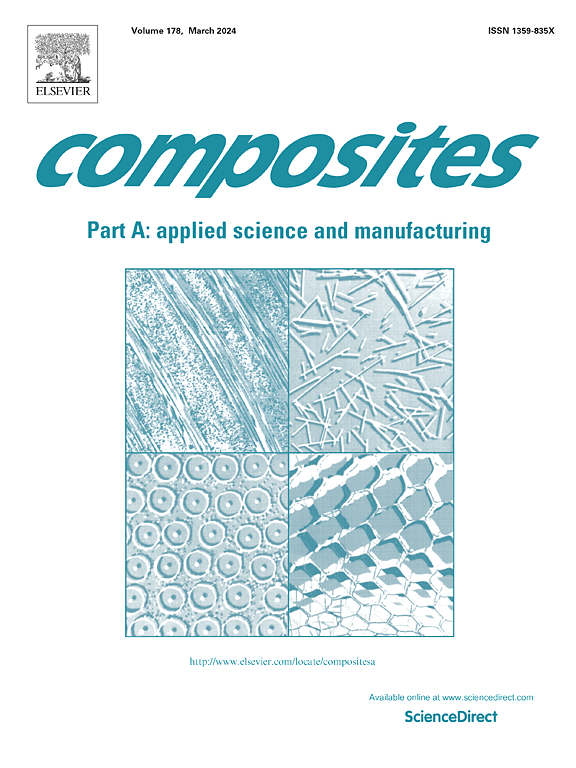考虑CF/环氧树脂和CF/PEEK弹塑性特性的切削机理理论分析
IF 8.1
2区 材料科学
Q1 ENGINEERING, MANUFACTURING
Composites Part A: Applied Science and Manufacturing
Pub Date : 2025-05-03
DOI:10.1016/j.compositesa.2025.109007
引用次数: 0
摘要
碳纤维增强塑料复合材料包括CF/PEEK和CF/环氧树脂是难以切割的材料。对其材料去除行为进行精确建模是深入理解和有效控制切削过程的必要条件。以往的切削模型没有充分考虑材料的塑性,导致对切削过程的预测不准确,特别是对于高塑性复合材料和高温条件下的切削过程。本文提出了一种考虑基体弹塑性特性的切削复合材料的理论模型。该模型首先表征了纤维与基体之间的耦合约束关系,并定量分析了基体弹塑性性能对材料去除的影响。CF/PEEK和CF/环氧树脂在25 °C和200 °C下进行了对比研究和验证。与不考虑塑性的模型相比,该模型对亚表面损伤、切削力和推力的预测精度分别提高了13.48%、5.49%和17.47%。此外,还通过模型阐明了基体塑性对材料去除过程的影响机理。具体而言,由于其优越的延展性,CF/PEEK经历了更严重的亚表面损伤,特别是在200 °C下,而切割力比切割CF/环氧树脂要低。本文章由计算机程序翻译,如有差异,请以英文原文为准。
Theoretical analysis of cutting mechanisms for CF/epoxy and CF/PEEK considering their elasto-plastic properties
Carbon fiber-reinforced plastic composites including CF/PEEK and CF/epoxy are hard-to-cut materials. Accurate modeling of their material removal behavior is essential for deep understanding and effective control of cutting process. Previous cutting models have not fully considered material plasticity, resulting in inaccurately predicting cutting process, particularly for highly plastic composites and under high-temperature conditions. This paper proposed a novel theoretical model for cutting composites considering matrix elasto-plastic properties. The model first characterized the coupled constraint relationship between fiber and matrix, and quantitatively analyzed the impact of matrix elasto-plastic properties on material removal. Comparative investigations and validations for CF/PEEK and CF/epoxy were conducted under 25 °C and 200 °C. The proposed model has improved predicting accuracy for subsurface damage, cutting force and thrust force by 13.48%, 5.49%, and 17.47%, respectively, comparing to that without considering plasticity. Moreover, the influence mechanism of matrix plasticity on the material removal process was elucidated by the model. Specifically, due to its superior ductility, CF/PEEK experienced more serious subsurface damage, especially under 200 °C, while the cutting forces were lower compared to cutting CF/epoxy.
求助全文
通过发布文献求助,成功后即可免费获取论文全文。
去求助
来源期刊

Composites Part A: Applied Science and Manufacturing
工程技术-材料科学:复合
CiteScore
15.20
自引率
5.70%
发文量
492
审稿时长
30 days
期刊介绍:
Composites Part A: Applied Science and Manufacturing is a comprehensive journal that publishes original research papers, review articles, case studies, short communications, and letters covering various aspects of composite materials science and technology. This includes fibrous and particulate reinforcements in polymeric, metallic, and ceramic matrices, as well as 'natural' composites like wood and biological materials. The journal addresses topics such as properties, design, and manufacture of reinforcing fibers and particles, novel architectures and concepts, multifunctional composites, advancements in fabrication and processing, manufacturing science, process modeling, experimental mechanics, microstructural characterization, interfaces, prediction and measurement of mechanical, physical, and chemical behavior, and performance in service. Additionally, articles on economic and commercial aspects, design, and case studies are welcomed. All submissions undergo rigorous peer review to ensure they contribute significantly and innovatively, maintaining high standards for content and presentation. The editorial team aims to expedite the review process for prompt publication.
 求助内容:
求助内容: 应助结果提醒方式:
应助结果提醒方式:


